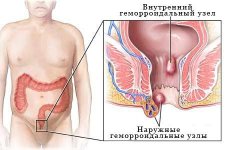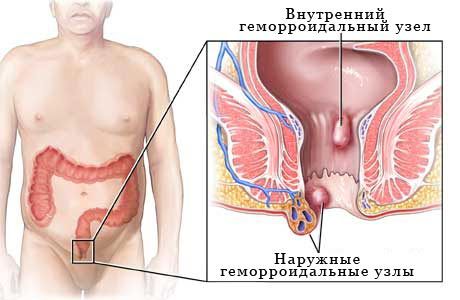What is hemorrhoids?
Last reviewed: 23.04.2024

All iLive content is medically reviewed or fact checked to ensure as much factual accuracy as possible.
We have strict sourcing guidelines and only link to reputable media sites, academic research institutions and, whenever possible, medically peer reviewed studies. Note that the numbers in parentheses ([1], [2], etc.) are clickable links to these studies.
If you feel that any of our content is inaccurate, out-of-date, or otherwise questionable, please select it and press Ctrl + Enter.

Although most people think that hemorrhoids are an abnormal phenomenon, it can disturb everyone. This phenomenon, when hemorrhoidal cavernous bodies increased and filled with blood, and then there is pain in the anus. Then hemorrhoids can cause problems and be considered an abnormal condition or disease.

Definition of hemorrhoids
There is no precise definition of hemorrhoids, but it can be described as masses or bundles of tissue "pads", grapes, peas in the anal canal area, which contains blood vessels and surrounding them, supporting muscles. In the anal canal there is a site - the last four centimeters, through which the feces pass from the rectum. The anus is an open anal canal from the human body to the outside world.
Prevalence of hemorrhoids
Although hemorrhoids are present in hidden form in every person, until the cones become large, hemorrhoids can cause problems in 4% of the total population. Hemorrhoids cause health problems equally for men and women. His peak prevalence is between 45 and 65 years.
Factors that increase the risk of hemorrhoids
- Persistent constipation or diarrhea. These symptoms can lead to stress during defecation.
- Overweight
- The history of hemorrhoids, which hurt family members. You can inherit this disease.
- Age 50 years or older. Half of people over 50 are looking for ways to treat hemorrhoids.
- Pregnancy. When the fetus grows during the last 6 months of pregnancy, blood raises pressure on the pelvic organs, blood vessels, increases the risk of hemorrhoidal cones.
- Hard work can also cause hemorrhoids, which will eventually worsen, if not change their habits to lifting weights.
- Diseases of the liver, heart, legs, or all of these diseases in the complex. These circumstances can lead to blood cones in the anus.
Factors that can aggravate the course of hemorrhoids
Hemorrhoids may worsen under the following circumstances
Circumstances associated with hemorrhoids
Need help to ease pain, itching, hemorrhoids? Better yet, what would you like to do to prevent outbreaks of pain in the first place? About 10 million people only in the United States suffer from hemorrhoids, when veins are blown in the rectum or around the anus.
Hemorrhoids can be internal or external. External hemorrhoids often cause symptoms, pain and itching with irritation of the anus. Internal hemorrhoids are usually painless, but can cause bleeding. Hemorrhoids can cause bright red rectal bleeding, but if you have a bleeding, we will assume ...
Prolonged sitting or standing position. This can lead to the formation of blood in the anal region and increase pressure on the veins. Frequent severe breathing delay when lifting heavy objects. This can cause a sharp increase in pressure in the blood vessels and hemorrhoids.
Who suffers the most from hemorrhoids
Hemorrhoids are a very common problem. Equal numbers of men and women suffer from hemorrhoids.
Hemorrhoids can occur at any age, but it is more common after 30 years of age. About half of people over the age of 50 have symptoms of hemorrhoids.
Many women suffer from hemorrhoids during the last 6 months of pregnancy and immediately after childbirth.
Do you know that ...
Hemorrhoids - one of the most common diseases known to mankind. More than half of the population develops hemorrhoids, usually after 30 years. Millions of people now suffer from hemorrhoids.
On average, a person silently suffers from hemorrhoids for a long period before seeking medical help.
Today, many therapies do some types of hemorrhoids when removed much less painful.
Anatomy of a hemorrhoids
The arteries that supply blood to the anal canal pass from the rectal canal and up and form a rich network of arteries that communicate with each other around the anal canal. Because of this rich network of arteries, hemorrhoidal blood vessels are ready to supply arterial blood. This explains why bleeding from the hemorrhoid cones is bright red (arterial), not dark red (venous blood), and why bleeding from hemorrhoids can sometimes be a very serious symptom. Blood vessels that feed the hemorrhoidal vessels pass through the tissues of hemorrhoidal cavernous bodies.
Anal veins provide the outflow of blood from the anal canal. These veins pass in two directions. The first direction is up in the rectum, and the second - down under the skin around the anus. Toothed line - the line in the anal canal area means the transition from the anal area of the skin (anoderm) to the rectal mucosa.
 [12], [13], [14], [15], [16], [17]
[12], [13], [14], [15], [16], [17]
Formation of hemorrhoids
If hemorrhoids occur on the rectal side of the anal canal, this is internal hemorrhoids. If this occurs in the lower part of the anal canal near the anus, it is called external hemorrhoids. Technically, the distinction between internal and external hemorrhoids occurs on the basis that the cones of hemorrhoids are formed above or below the dentate lines (internal and external, respectively).
As discussed earlier, the hemorrhoid cones in the upper anal canal consist of blood vessels and supporting muscle tissues. Usually there are three main hemorrhoidal pillows, oriented as the right hind, right front, left lateral. In the formation of an enlarged internal hemorrhoids, the vessels of the anal pads become inflated, and the tissues supporting them increase in size.
Parts of tissues and blood vessels protrude from the anal canal, which can be the cause of the problem. Unlike internal hemorrhoids, it is not clear how external hemorrhoids form.
How to visually identify hemorrhoids
Internal hemorrhoids are shreds of tissue in the anal canal, which contains blood vessels, muscles and elastic fibers. External hemorrhoids are when the blood vessels around the anus widen.
Internal hemorrhoids can cause problems when lumps increase in size. The reason for the expansion is often unknown.
Complications of hemorrhoids include bleeding, anal itching, prolapse of the rectum, constipation and gangrene. Pain may not be.
The main complication of external hemorrhoids is pain due to blood clotting in the hemorrhoidal blood vessels.
When working with the removal of hemorrhoids, it is important to exclude other diseases of the anus and rectum, which can cause similar symptoms, such as polyps, cancer and skin diseases.
Treatment of hemorrhoids includes over-the-counter and prescription topical medications, sclerotherapy, a rubber tape for bandaging cones, heat, coagulation, cryotherapy, anal stretching, doppler of the fallopian tubes and surgical methods of exposure.
Cardinal treatment of hemorrhoids involves hemorrhoidectomy (excision of hemorrhoids).
Emptying the bowels, physical stress and other factors may increase the risk of hemorrhoids or make an already existing situation with hemorrhoids even worse. Some of these factors can be prevented.

